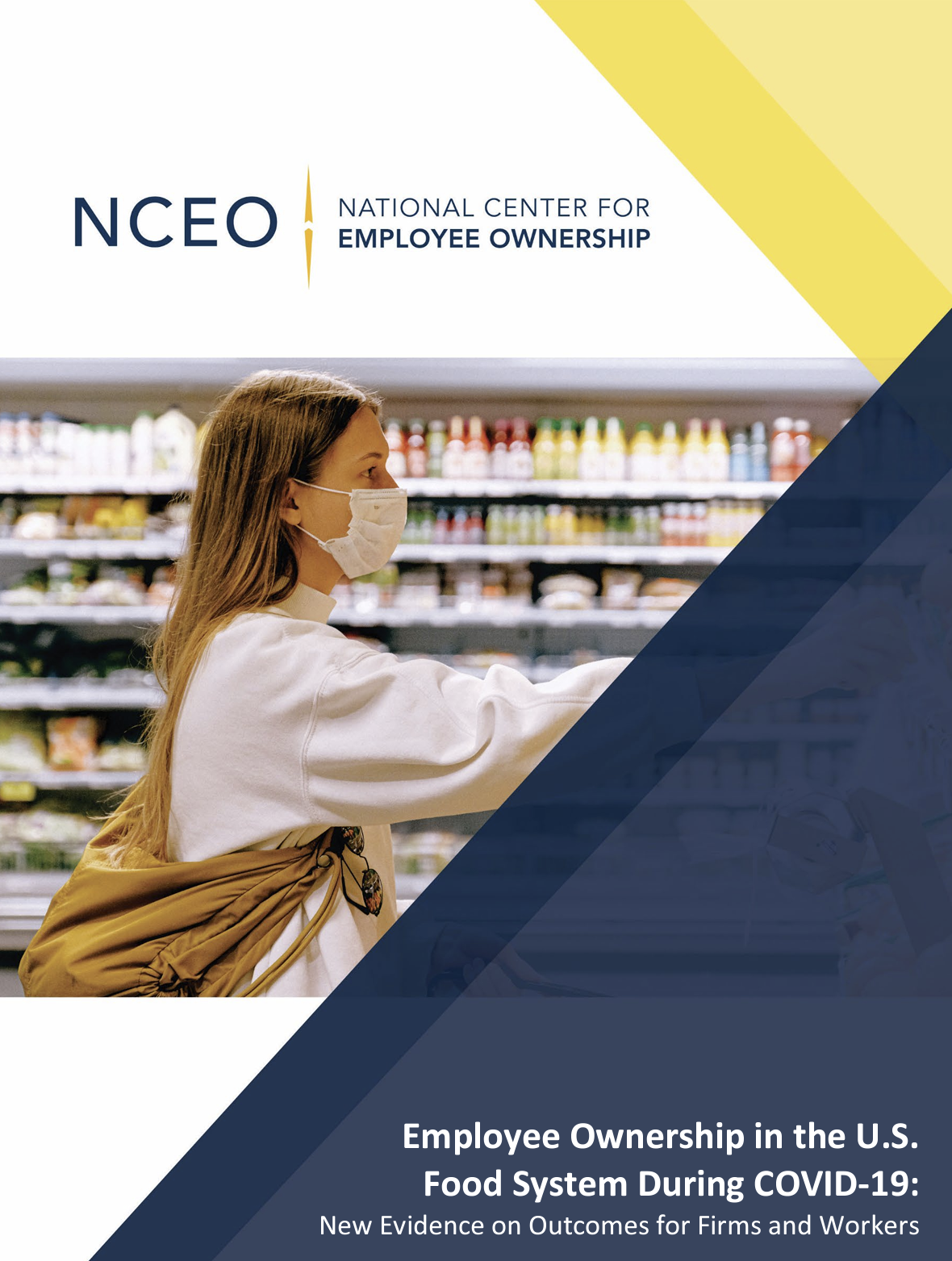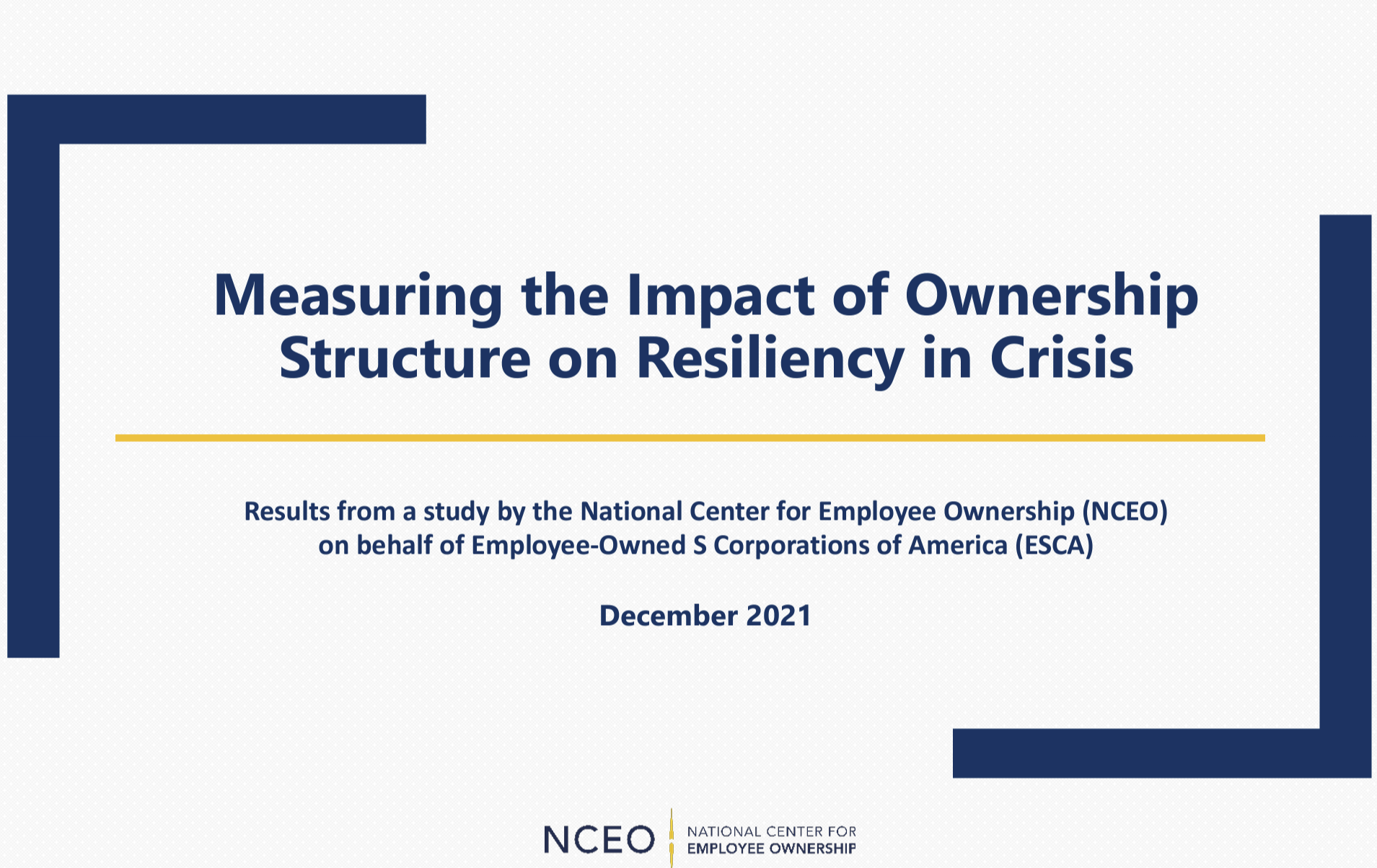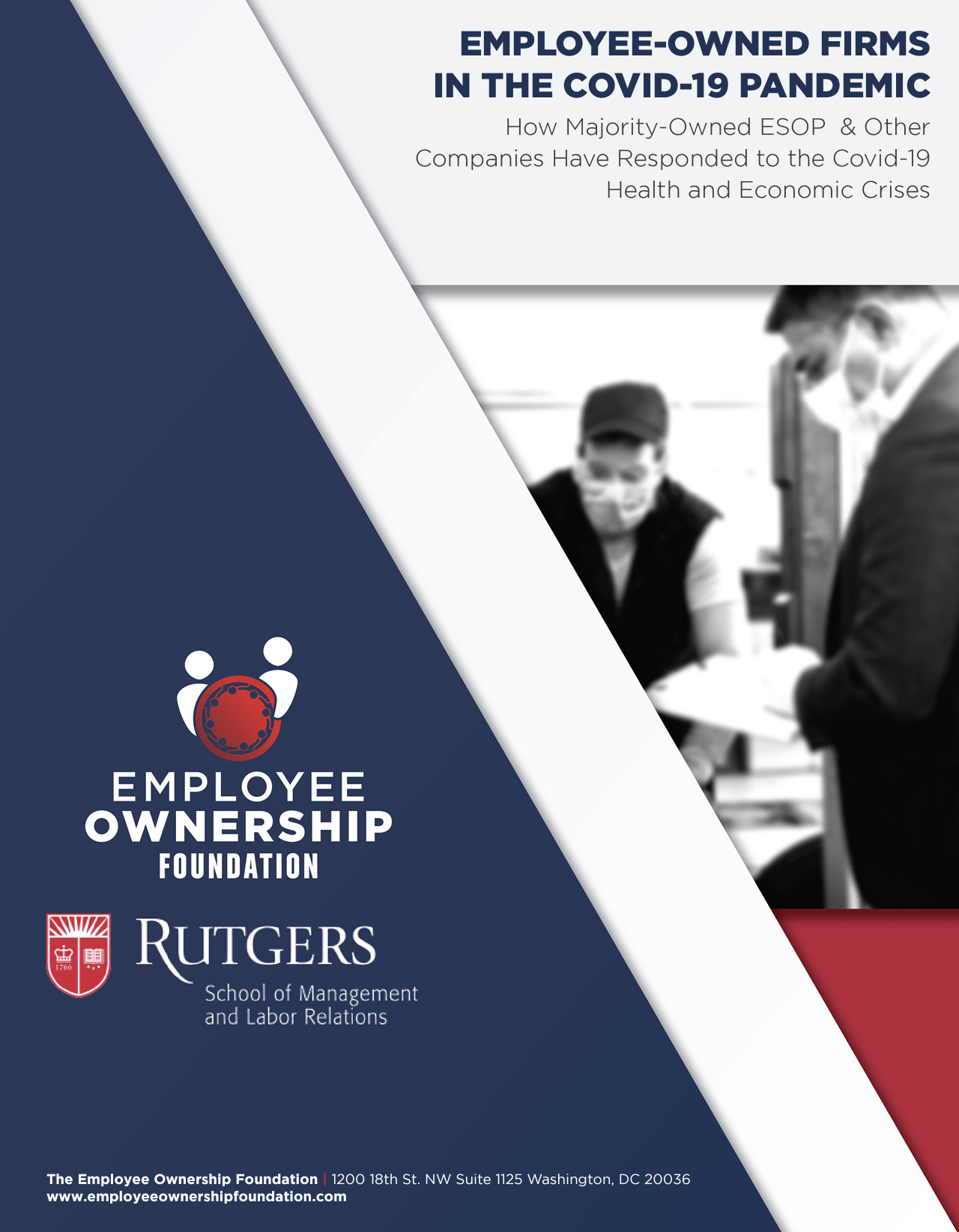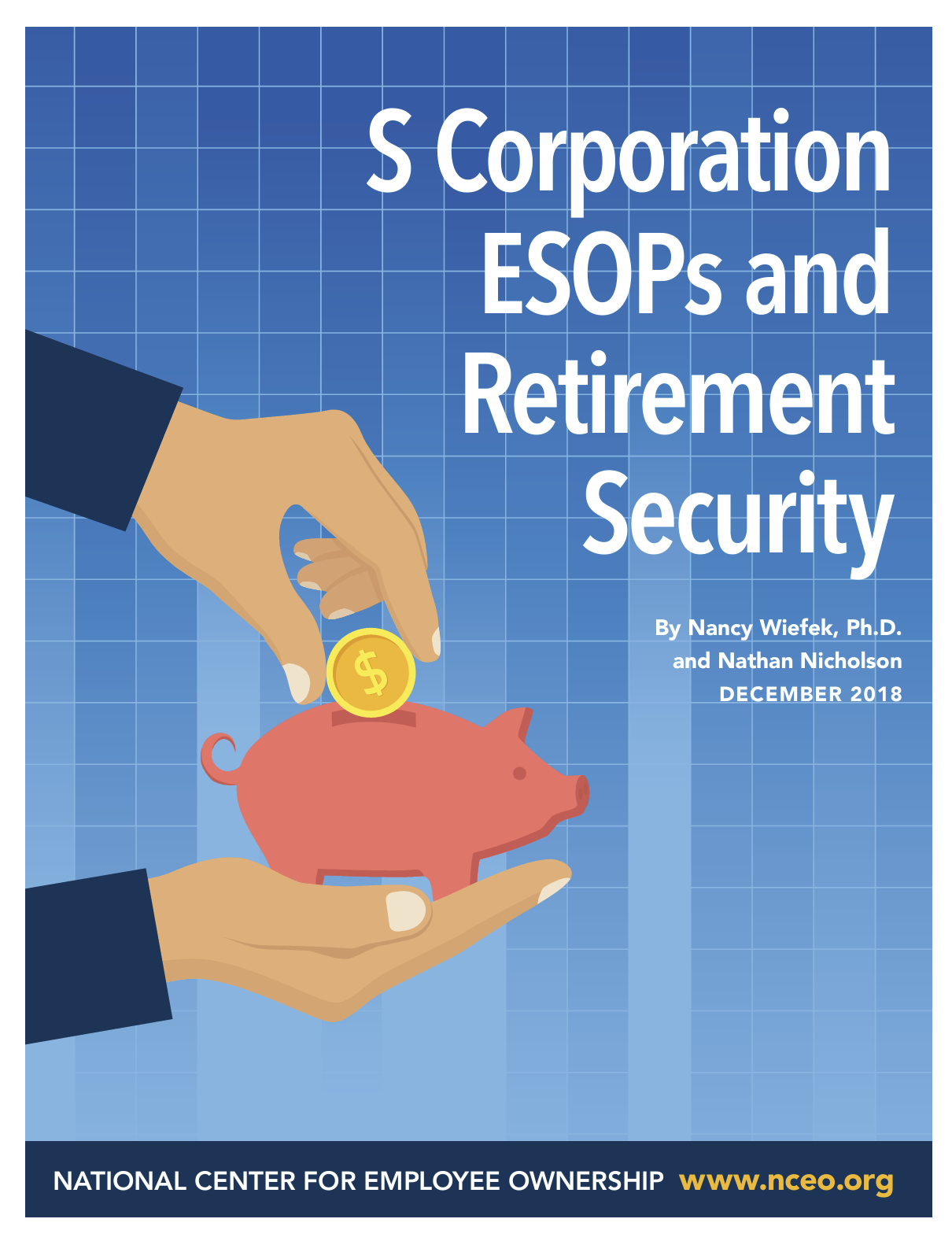
What the Research Says: The Impact of Employee Ownership
A large body of research explores the effects of employee ownership on firms and employees. This page provides a guide to key findings.
Recent studies by the NCEO and others
S Corporation ESOPS: Advantages in an Uncertain Economy
NCEO study conducted with the support of Employee-Owned S Corporations of America (ESCA), 2023
In this 2023 study, ESOPs reported voluntary quit rates of their employees at roughly one-third of the national average. In addition, the study found that employee owners at S corporation ESOPs have, on average, more than double the retirement savings (median ESOP account balance of $80,500) in comparison to non-ESOP counterparts (median of $30,000).
Employee Ownership in the U.S. Food System During Covid-19: New Evidence on Outcomes for Firms and Workers
NCEO study, 2022
This 2022 study by the NCEO, focusing on ESOPs in food-related industries, found that employee ownership was associated with substantial benefits for employees and companies during the COVID-19 pandemic. Drawing on a robust survey sample of ESOP and comparable non-ESOP food companies, the study found that ESOP companies fared better in terms of workforce retention, benefits and retirement security, and firm performance in 2020. ESOP food companies had lower median involuntary separation rates (2% vs. 5%), were more likely to offer employer-paid healthcare (89% vs. 71%), and were more likely to have seen revenue increases from 2019 to 2020 (53% vs. 35%).
Measuring the Impact of Ownership Structure on Resiliency in Crisis
NCEO study conducted with the support of Employee-Owned S Corporations of America (ESCA), 2021
This 2021 study by the NCEO found that workers at S corporation ESOP companies had more retirement savings and more employer-side retirement contributions both before and during COVID-19, compared to companies offering only a 401(k) plan. S ESOP companies' retirement contributions were 2.6 times that of companies offering only 401(k) plans. Additionally, the vast majority of total contributions to these ESOPs, 94%, were from employers, compared to 31% for 401(k) plans. Controlling for size, industry, and region, the study found that average S ESOP participant retirement balances were $67,000 higher than the comparison group. The study also found evidence that ESOP companies retained or created more jobs during 2020, again controlling for size, industry, and region.
Employee-Owned Firms in the Covid-19 Pandemic: How Majority-Owned ESOP and Other Companies Have Responded to the Health and Economic Crises
Rutgers School of Management and Labor Relations and the Employee Ownership Foundation, 2020
This 2020 study found that employee owned companies outperformed non-employee owned companies in job retention, pay, and workplace health safety throughout the COVID-19 pandemic. The study found that ESOP companies were 3 to 4 times more likely to retain staff, less likely to make pay cuts (26.9% vs. 57.3%), and more likely to take protective measures against the spread of COVID-19 (98.3% vs. 88.9%).
S Corporation ESOPs and Retirement Security
NCEO study conducted with the support of Employee-Owned S Corporations of America (ESCA), 2018
This 2018 study found that ESOP participants represented in the survey have more than twice the average total retirement balance of Americans nationally, and that those making less than $26,000 a year also have on average more than double the retirement savings compared to similar workers nationally.
More research findings on employee ownership
Firm performance
- A meta-analysis of empirical studies on employee ownership published in the English language as of 2013 (102 studies representing 56,984 firms) found a small but positive and statistically significant relationship to firm performance ( r̅ =0.04). Their analysis was based on studies reporting on the effectiveness of broad-based employee stock ownership or employee stock option plans. The findings indicate that firms with ESOPs significantly outperform firms not offering ESOPs. Further, on average, as ESOP participation increases within organizations, so too does firm profitability. This small but robust relationship persists across a variety of conditions. [1]
- Taken together, studies conducted in the 1980s and 1990s by noted scholars and practitioners found productivity increases of up to 4-5%, on average, in the year an ESOP is adopted. [2]
- A study examined 300 privately held companies that set up ESOPs between 1988 and 1994, comparing each ESOP firm to a similar company of the same size and in the same industry without an ESOP. It found that ESOP firms have significantly higher sales growth and higher sales per worker than matching firms without ESOPs. [3]
- A study conducted in 1986 found significantly higher post-adoption growth for privately-held ESOP companies that had participation groups and for ESOP companies in which management perceived higher worker influence (compared to both similar non-ESOP companies and to pre-adoption growth). The study found that ESOP companies had sales growth rates 3.4% per year higher and employment growth rates 3.8% per year higher in the post-ESOP period than would have been expected based on pre-ESOP performance. When the companies were divided into three groups based on how participatively managed they were, however, only the most participative companies showed a gain. These companies grew 8% to 11% per year faster than they would have been expected to grow, while the middle group did about the same, and the bottom group showed a decline in performance. [4]
- A study conducted in Washington state examining the period 1988-91 found higher sales and employment growth in participatory ESOP companies compared to non-participatory ESOP companies and non-ESOP companies. [5]
- In the early years of ESOPs, the General Accounting Office (GAO) did studies in the 1980s that concluded that ESOPs do broaden stock ownership and that employee ownership does not lead to improved worker productivity or corporate profitability in the absence of worker participation. [6]
Note: Most research on the relationship between company performance and employee ownership has been conducted on publicly held firms due to data availability issues: It is very challenging to collect data on profits and performance of privately held firms.
Correlation is not causation. ESOPs may perform better because only companies that are performing solidly can become ESOPs. That is why studies that compare ESOPs before and after adoption to similar non-ESOPs during the same time period are the gold standard.
Employment stability and survival
- Looking at the universe of publicly traded firms during 1999-2011, firms with employee ownership (a firm reported any employee ownership stock in any of its defined contribution pension plans, including employee ownership in 401(k) plans, ESOPs, and deferred profit-sharing plans in a given year) are linked to greater employment stability in the face of an economic downturn when measured as macroeconomic negative shocks as well as firm-specific negative shocks. They are also more likely to survive the last two recessions. [7]
- A study tracking the entire population of ESOP companies over ten years (1998 - 1999) found that privately-held ESOPs were only half as likely as non-ESOP firms to go bankrupt or close and only three-fifths as likely to disappear for any reason. [8]
- Park, Kruse and Sesil (2004) used data on all U.S. public companies as of 1988, following them through 2001 to examine how employee ownership is related to survival. They count any ownership of employer stock through an ESOP, deferred profit-sharing plan, 401(k) plan, or other broad-based defined contribution plan (excluding direct stock purchase plans, and plans limited to top managers). Estimation using Weibull survival models shows that companies with employee ownership stakes of 5% or more were only 76% as likely as firms without employee ownership to disappear in this period, compared both to all other public companies and to a closely matched sample without employee ownership. In every category tracked (Merger or Acquisition, Bankruptcy, Liquidation, Reverse Acquisition, Leveraged Buyout, Privatization, Other, and Missing) non-employee owned firms disappeared at a greater rate than employee-owned firms. The greater survival rate of these companies is linked to their greater employment stability. [9]
- Researchers compiled a unique data set that looked at all firms that were publicly traded in 1983 and that had approximately 20 percent or more of their common stock in employee stock ownership plans (ESOPs), profit-sharing plans, or other employee-benefit plans. They compared employee-owned firms to a control sample of firms matched by size and industry and the whole population of non-employee-owned firms tracked by Compustat, in terms of productivity, employment stability, and financial performance, looking at how the firms weathered various crises. They used duration-model analysis to test whether employee ownership is associated with a greater or a reduced "survival" rate (as in whether the firm continued to exist as a separate publicly traded corporate entity with substantial employee ownership). And they compared the stock market performance of employee ownership firms to non-employee ownership firms by analyzing the performance of a hypothetical portfolio of employee ownership firms, compared with a comparably constructed portfolio of control firms. They concluded that the ownership of a substantial block of shares by employees appears to be a relatively stable arrangement; "stabilizing" the firm itself, by making it less likely that the firm will be acquired, taken private, or thrust into bankruptcy. And it appears to achieve this result without cost in terms of productivity or financial performance, and may in fact enhance performance. [10]
Impact on employees' financial well-being
- A 2017 report conducted by the NCEO with support from the W.K. Kellogg Foundation compared workers early in their careers, ages 28 to 34, with employee ownership to their peers without and found that being in an ESOP was associated with 92% higher median household net wealth, 33% higher median income from wages, and 53% longer median job tenure. Find more information and the full paper at www.ownershipeconomy.org.
- A study conducted by the NCEO, with funding from the Employee Ownership Foundation, in 2010 using Form 5500 data found ESOP participants to have 2.2 times as much in retirement plans and 20% more financial assets overall compared to the comparison group at non-ESOP companies. See the full study here (19-page PDF), and the supplemental tables here (12-page PDF).
- National surveys [11] show that among employees at private firms both actual layoffs [12] and the perceived likelihood of being laid off [13] are lower for employee-owners than for nonowners (employee-owners are identified based on the GSS variable ownstock, which asks respondents if they own any shares of stock in the company where they now work, either directly or through some type of retirement or stock plan). These results are maintained when restricted to employees with more than one year of tenure, and when controlling for tenure, occupation, gender, race, age, and education. [14]
- Other analysis of this GSS data with controls for job and demographic characteristics finds that employee owners have higher levels of yearly earnings and are more likely to say they are "paid what they deserve" and that their fringe benefits are good. [15] Further, 69% of employee owners reported that they had received formal training [16] from their current employers in the past year compared to 42% among nonowners as of 2014 data. [17]
- A 1995 study conducted in Washington state matched up 102 ESOP companies with 499 comparison companies in terms of industrial classification and employment size. The median hourly wage in the ESOP firms was 8% higher than the median hourly wage in the comparison companies and the average was 12% higher. [18] Wage and employment data for 1995 for all 601 companies—102 ESOP companies and 499 matched controls—were obtained from the Employment Security Department.
- A study that combined longitudinal Census Bureau establishment data with all ESOP adoptions among publicly traded companies over the 1982 - 2001 period found that employee wages (excluding ESOP contributions) either increased (for small ESOPs) or stayed constant (for large ESOPs) after adoption, controlling for state-level and industry-level wage changes and other company characteristics. [19]
References
Firm performance (return to section):
[1] O'Boyle, E.H., Patel, P.C. and Gonzalez-Mulé, E. (2016) "Employee ownership and firm performance: a meta-analysis." Human Resource Management Journal doi: 10.1111/1748-8583.12115.
[2] Based on meta-analysis described in Kruse, D. and Joseph Blasi. 1997. "Employee Ownership, Employee Attitudes, and Firm Performance: A Review of the Evidence," in The Human Resources Management Handbook, Part 1. Edited by David Lewin, Daniel J.B. Mitchell, and Mahmood A. Zaidi. Greenwich, CT.: JAI Press.
[3] Joseph Blasi, Douglas Kruse, and Dan Weltmann (2013). "Firm Survival and Performance in Privately Held ESOP Companies." in Sharing Ownership, Profits, and Decision-Making in the 21st Century, Douglas Kruse, ed. Vol 14. In the series Advances in the Economic Analysis of Participatory and Labor-Managed Firms, UK: Emerald Group Publishing Limited, pp. 109 - 124.
[4] Corey Rosen and Michael Quarrey. 1987. "How Well is Employee Ownership Working?" Harvard Business Review. September 1987.
[5] Kardas, Peter, Katrina Gale, and Gorm Winther. 1994. Employment and sales growth in Washington state employee ownership companies: A comparative analysis. The Journal of Employee Ownership Law and Finance (Spring): 83-135.
[6] General Accounting Office, Employee Stock Ownership Plans: Little Evidence of Effects on Corporate Performance, GAP/PEMD-88-1 (1987).
Employment stability and survival (return to section):
[7] Kurtulus, Fidan Ana and Douglas L. Kruse. 2017. How Did Employee Ownership Firms Weather the Last Two Recessions?: Employee Ownership, Employment Stability, and Firm Survival in the United States: 1999-2011. Kalamazoo, MI: W.E. Upjohn Institute for Employment Research. https://doi.org/10.17848/9780880995276
[8] Blasi, Joseph R., Douglas L. Kruse, and Dan Weltmann. 2013. "Firm Survival and Performance in Privately Held ESOP Companies." In Sharing Ownership, Profits, and Decision-Making in the 21st Century, Douglas L. Kruse, ed. Vol. 14 in the series Advances in the Economic Analysis of Participatory and Labor-Managed Firms, Takao Kato, ed. Bingley, UK: Emerald Group Publishing, pp. 109-124.
[9] Park, Rhokeun & Kruse, Douglas & Sesil, James. (2004). Does employee ownership enhance firm survival?. Advances in the Economic Analysis of Participatory & Labor-Managed Firms. 8. 3-33. 10.1016/S0885-3339(04)08001-9.
Impact on employees' financial well-being (return to section):
[10] Blair, Margaret M. and Kruse, Douglas L. and Blasi, Joseph R., Employee Ownership: An Unstable Form or a Stabilizing Force?. The New Relationship: Human Capital In The American Corporation, Margaret M. Blair and Thomas Kochan, eds., Brookings Institution Press, 2000. Available at SSRN: https://ssrn.com/abstract=142146 or http://dx.doi.org/10.2139/ssrn.142146
[11] The General Social Survey (GSS) is a nationally representative, face-to-face survey covering a broad range of behavior and attitudes conducted by the National Opinion Research Center (NORC) at the University of Chicago.
[12] Based on the GSS variable laidoff, which indicates whether the employee was laid off from his or her main job at any time in the past year.
[13] Based on the GSS variable joblose, which asks the respondent how likely he/she is to lose his/her job in the coming year.
[14] As reported in Kurtulus, Fidan Ana and Douglas L. Kruse. 2017. How Did Employee Ownership Firms Weather the Last Two Recessions?: Employee Ownership, Employment Stability, and Firm Survival in the United States: 1999-2011. Kalamazoo, MI: W.E. Upjohn Institute for Employment Research. https://doi.org/10.17848/9780880995276
[15] Kruse, D. L., Freeman, R. B., Blasi, J. R. 2010, "Do workers gain by sharing: Employee outcomes under employee ownership, profit sharing, and broad-based stock options?" In: Kruse, D. L., Freeman, R. B., Blasi, J. R. (eds). Shared Capitalism at Work: Employee Ownership, Profit and Gain Sharing, and Broad-based Stock Options. Chicago: University of Chicago Press, pg. 266.
[16] Based on the GSS variable emptrain, which asks, "In the last 12 months, have you received any formal training from your current employer, such as in classes or seminars sponsored by the employer?"
[17] As reported in Kurtulus, Fidan Ana and Douglas L. Kruse. 2017. How Did Employee Ownership Firms Weather the Last Two Recessions?: Employee Ownership, Employment Stability, and Firm Survival in the United States: 1999-2011. Kalamazoo, MI: W.E. Upjohn Institute for Employment Research. https://doi.org/10.17848/9780880995276
[18] Kardas, Peter; Adria L. Scharf & Jim Keogh 1998. Wealth and income consequences of ESOPs and employee ownership: a comparative study from Washington State, Journal of Employee Ownership Law and Finance.10(4).
[19] Kim, E.H. and Ouimet, P. (2014). "Broad-based employee stock ownership: motives and outcomes." The Journal of Finance, 69: 3, 1273-1319.




